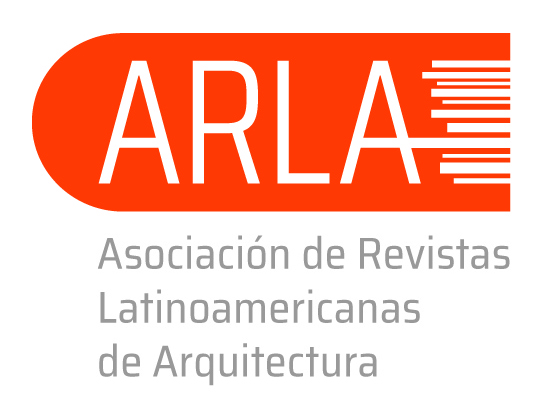University building with almost zero energy and carbon
Case of the National University of Santiago del Estero-Argentina
DOI:
https://doi.org/10.14409/ar.v12i22.11196Keywords:
educational buildings; energy efficiency; recycled thermal insulation; climate change; sustainabilityAbstract
In the current situation that we are going through the sustained health, social, economic and environmental emergency due to anthropogenic causes, it is necessary to generate innovative initiatives to mitigate negative impacts. The contribution from the design of the educational habitat for sustainability should focus on reducing the environmental impact net Zero Energy Building (nZIB), both in existing and new buildings. In this sense, the objective of this research is to evaluate the reduction of energy and carbon equivalent of a university educational building, by incorporating a thermal insulator solved with textile industry scrap. The thermal and environmental behavior of the current situation and the improvement proposal are analyzed in a comparative way. The results obtained are very encouraging. In the improved case in relation to the existing one, a reduction in energy in air conditioning is achieved, in the order of 45% in heating, 23% in cooling and 34,4% in greenhouse gas emissions. In conclusion, energy rehabilitation alternatives that reflect triple impact benefits involving the entire university educational community and society in general are valued.
References
ABDUL–AZEEZ, I.; HO, C. (2015) Realizing Low Carbon Emission in the University Campus towards Energy Sustainability. Open Journal of Energy Efficiency, 4, 15–27. 10.4236/ojee.2015.42002
ALÍAS, H.M.; JACOBO, G.J.; MARTINA, PA. E. y CORACE, J.J. (2013). Auditorías higrotérmicas de edificios según su diseño tecnológico–constructivo: el caso de la Facultad de Arquitectura de la UNNE. ADNea Revista de Arquitectura y Diseño del nordeste argentino- Vol 1 N.º 1- (Diciembre 2013) Pp. 63-76 -ISSN 2347- 064X.
ÁLVAREZ, A.A. y RIPOLL–MEYER, V. (2018). Matriz de referencia para la optimización del ciclo de vida de los materiales constructivos de la vivienda social en zonas árido–sísmicas. Hábitat Sustentable, 8(2), 52–63. https://doi.org/10.22320/07190700.2018.08.02
ASDRUBALI, F.; D'ALESSANDRO, F. y SCHIAVONI, S. (2015). Una revisión de los materiales de aislamiento de edificios sostenibles no convencionales. Materiales y tecnologías sostenibles, 4, 1–17. https://doi.org/10.1016/j.susmat.2015.05.002
BEYRNE, G.; MALVICINO, F.; TRAJTENBERG, L.A. (2015). Modelo Estacional de Demanda de Energía Eléctrica. Documento de trabajo N°11. Subsecretaría de Programación Macroeconómica.
CARABAÑO, R.; HERNANDO, S.M.; RUIZ, D. y BEDOYA, C. (2017). Evaluación del ciclo de vida (ACV) de los materiales de construcción para la evaluación de la sostenibilidad de la edificación: el caso de los materiales de aislamiento térmico. Revista de la construcción, 16(1), 22–32. https://dx.doi.org/10.7764/RDLC.16.1.22
D’AGOSTINO, D. y PARKER, D. (2018). A framework for the cost–optimal designof nearly zero energy buildings (NZEBs) in representative climates across Europe. Energy, (149), 814–829. http://dx.doi.org/10.1016/j.energy.2018.02.020
DIRECCIÓN DE SUSTENTABILIDAD, MEDIO AMBIENTE Y CAMBIO CLIMÁTICO, MINISTERIO DE AGROINDUSTRIA PROVINCIA DE BUENOS AIRES (2018). Manual de aplicación de la Huella de carbono 2018. https://www.gba.gob.ar/sites/default/files/agroindustria/docs/Manual_aplicacion_Huella_de_Carbono.pdf
ESCOBAR, M.L.; ALÍAS, H.M. y JACOBO G.J. (2012). Estudio de alternativas de mejoramiento térmico de las envolventes del edificio de la FAU UNNE, mediante el software Retscreen. Avances en Energías Renovables y Medio Ambiente, 16. http://portalderevistas.unsa.edu.ar/ojs/index.php/averma/issue/view/164
FILIPPÍN, M.C.; FLORES LARSEN, S. y LESINO, G (2002). Simulación térmica de verano de un sector del bloque de residencias estudiantiles bioclimáticas en Santa Rosa, La Pampa. Avances en Energías Renovables y Medio Ambiente, 6, 19–24. Asociación Argentina de Energías Renovables y Medio Ambiente (ASADES). http://sedici.unlp.edu.ar/handle/10915/80339
FUNDACIÓN ELLEN MAC ARTHUR (2018). Hacia una economía circular: Motivos económicos para una transición acelerada. https://www.ellenmacarthurfoundation.org/assets/downloads/publications/Executive_summary_SP.pdf
GIORDANO, R.; SERRA, V.; DEMARIAA, E. y DUZEL, A. (2017). Embodied energy versus operational energy in a nearly zero energy building case study. Energy Procedia, 111, 367–376. https://doi.org/10.1016/j.egypro.2017.03.198
GONZÁLEZ, C.; JAVIER, R.; RODRÍGUEZ, R. y RODRÍGUEZ, L. (2020). Análisis de ciclo de vida del Edificio NZEB El Salvador: modelo base para calcular huella de carbono. Universidad Centroamericana José Simeón Cañas. http://hdl.handle.net/2117/346366
HERRANDO, M.; CAMBRA, D.; NAVARRO, M.; GEMA MILLÁN, L.; ZABALZA, I. (2016). Energy Performance Certification of Faculty Buildings in Spain: The gap between estimated and real energy consumption. Energy Conversion and Management, 125, 1, 141–153. https://doi.org/10.1016/j.enconman.2016.04.037
IPCC (2021). Resumen para responsables de políticas de la contribución del Grupo de trabajo I al Sexto Informe de Evaluación del IPCC. NERC EDS Center for Environmental Data Analysis. http://catalogue.ceda.ac.uk/uuid/ae4f1eb6fce24adcb92ddca1a7838a5c
KÔPPEN, W. (1936) Das geographische System der Klimate, Handbuch der Klimatologie [The Geographical System of the Climate, Handbook of Climatology]. Borntraeger, Berlin, Bd. 1, Teil. C.
LEITE FRANDOLOSO, M.A (2018). La inserción de la eficiencia energética en los edificios universitarios brasileños: las políticas y los procesos de toma de decisiones. (Tesis doctoral, UPC, Departament de Tecnologia de l'Arquitectura). http://hdl.handle.net/2117/113995
GARZÓN B., y MENDONCA, C. (2013). TRANS–Q–E: Programa calculador de transmitancia, cargas térmicas de calefacción y refrigeración y consumos energéticos, según serie normas de IRAM 11 600. Obra Inscripta en Dirección Nacional de Derechos de Autor (DNDA), CABA, Buenos Aires.
MASTRONARDI, L.; SFEIR, M.A. y SANCHEZ, S. (2016). La temperatura y su influencia en la demanda de energía eléctrica: Un análisis regional para Argentina usando modelos econométricos. Subsecretaría de Escenarios y Evaluación de Proyectos. Secretaría de Planeamiento Energético Estratégico. Ministerio de Energía y Minería de la Nación.
ONU (2019.) Informe de los Objetivos de Desarrollo Sostenible. Naciones Unidas. Departamento de Asuntos Económicos y Sociales (DESA).
UNSE (2019a). Plan estratégico de la Universidad Nacional de Santiago del Estero (pp. 1–78). https://www.unse.edu.ar/index.php/plan
UNSE (2019b). Res. HCS 204/2019 (p. 6). https://www.unse.edu.ar/unseverde/
WADEL, G. (2009). Aislamientos térmicos renovables y reciclados de lana de oveja y algodón: un aporte a la construcción sostenible. Revista de Arquitectura, 15(20), 27–32. https://doi.org/10.5354/0719-5427.2013.27962
YÁÑEZ, J.I. (2018). Campus Sostenible 2018. Autoevaluación de la Sostenibilidad del Campus de la UNVM. I Congreso Iberoamericano de Educación Para La Sustentabilidad Universitaria.
Normas
IRAM 11900 (2019). Modificación Nº 1 a la Norma IRAM 11900:2017–12. Prestaciones energéticas de viviendas. Métodos de cálculos. Instituto Argentino de Normalización y Certificación.
IRAM–ISO Serie 14000 (2008). Gestión Ambiental Análisis de ciclo de vida. Instituto Argentino de Normalización y Certificación.
Published
How to Cite
Issue
Section
License
Copyright (c) 2022 ARQUISUR

This work is licensed under a Creative Commons Attribution-NonCommercial-NoDerivatives 4.0 International License.
ACCESO ABIERTO
ARQUISUR Revista es una publicación de acceso abierto y sin ánimo de lucro. No se imputan cargos por la recepción, revisión, evaluación, publicación ni acceso a sus contenidos. Se distribuye bajo una Licencia Creative Commons CC Atribución-NoComercial-SinDerivadas 4.0 Internacional (CC BY-NC-ND 4.0): No se permite un uso comercial de la obra original ni la generación de obras derivadas. Esta licencia no es una licencia libre, y es la más cercana al derecho de autor tradicional.
DESCARGO
Los criterios expuestos en los artículos son de exclusiva responsabilidad de sus autores y no reflejan necesariamente la opinión del Comité Editorial ni de la Dirección Editorial Técnica. Los derechos de los artículos publicados pertenecen a sus autores o editoriales. Los autores ceden sus derechos de publicación al Centro de Ediciones de la Universidad Nacional del Litoral de Santa Fe, Argentina.














